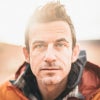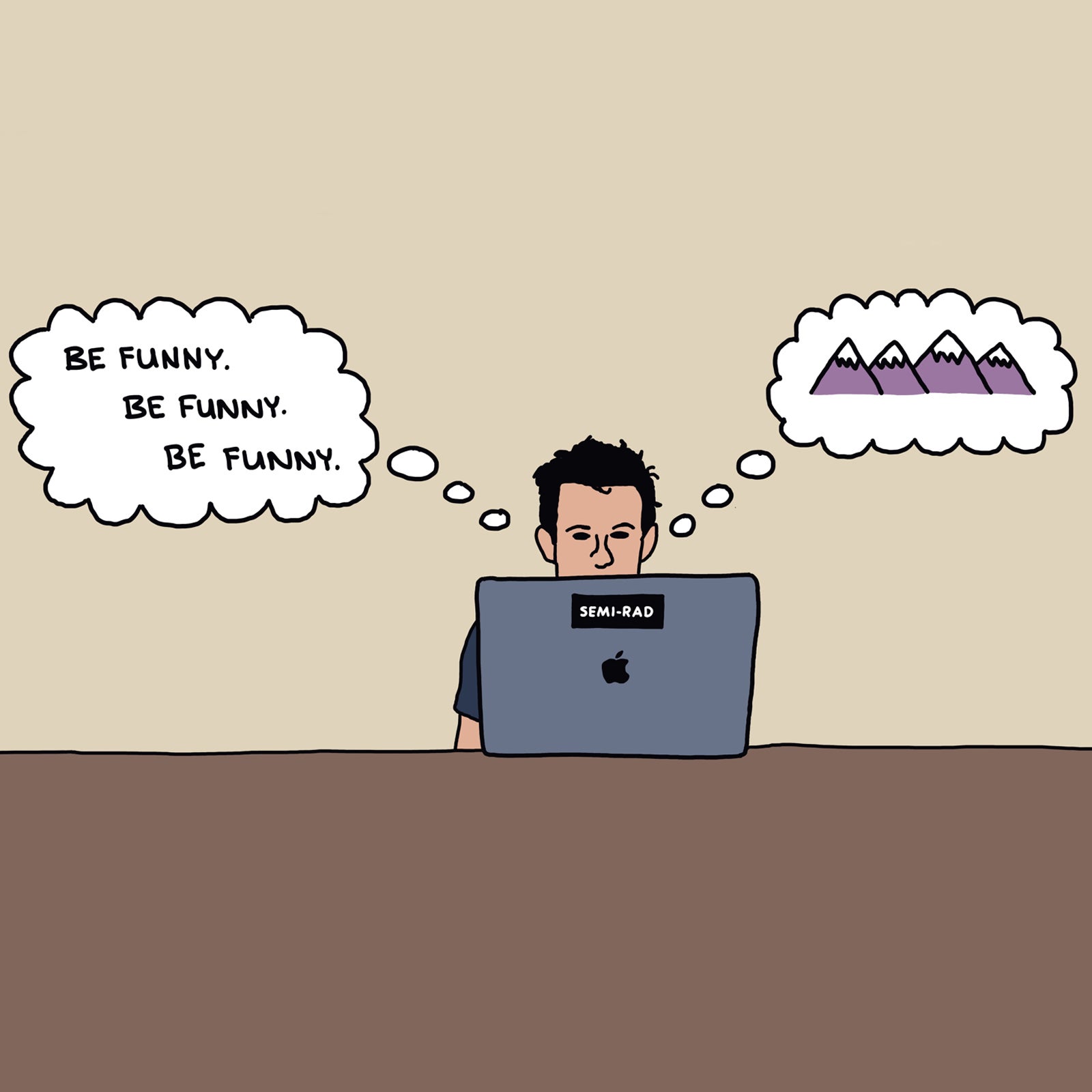One afternoon last August, a delivery truck rolled up outside my house in Denver. Two men got out, dollied a large box through the front door, unpacked a six-foot long wooden workbench top and gave it a once-over to see if it had been damaged in shipping. I signed for the delivery, carried the wood and accompanying metal legs back to a ten-foot by ten-foot room at the back of our duplex, and put it all together.
A few minutes later, I dusted off my hands and stood in front of it: the first real desk of my outdoor writing career.
I’d been trying to be an adventure writer since 2004, been trying at it full-time since 2012—and I’d never had a place to set my laptop, pile up notebooks, stick post-it notes, or leave a printer plugged into a wall outlet. I’d typed in coffee shops, at friends’ kitchen tables, in the back of a van, at my own kitchen table, at airports, laundromats, anywhere I could when I had to. But now. A desk, in its own room. I must be a real writer now, right?
It’s funny how your definition of “real” changes.
In the spring of 2004, I had decided I was going to be an adventure writer. Not immediately, but someday. I had discovered Mark Jenkins’ columns in �����ԹϺ���, read Daniel Duane’s (despite never having climbed or seen El Cap), and tore through Jon Krakauer’s and . The model I understood from those writings—going on big adventures and writing stories about them—seemed like a dream job, although I had no idea if it was an actual job, or how a person could get that job. I did my master’s thesis at the University of Montana School of Journalism on peak bagging, and as a requirement for my magazine writing class, I had gotten published—an article in Idaho Magazine about a road trip I’d taken the previous summer. The check for the article was for $40, or would have been, had I not asked the editor to please send me $40 worth of copies of the magazine instead, because I was so excited to have been published. It was a start, I thought. A slow one, but a start nonetheless. At $40 per article, I’d have had to write 233 articles each year just to crest the poverty line in 2004.
So I needed a real job, too. I applied at newspapers with no luck, so I got a job on the sales floor at the Phoenix REI to work while I sent out resumes and made calls to prospective journalism employers. I finally got a full-time editor/reporter/copy editor job at a small suburban weekly newspaper, and stayed on working part-time at REI.
In my spare time, I pitched every outdoor magazine I knew of, writing query letters that almost without fail resulted in rejection letters sent back to me weeks or months later. It was like walking up to a sport climbing crag, trying a route, falling after clipping the first bolt, failing to climb any higher, and moving on to the next route and repeating the process, with nothing to show for it. For months.
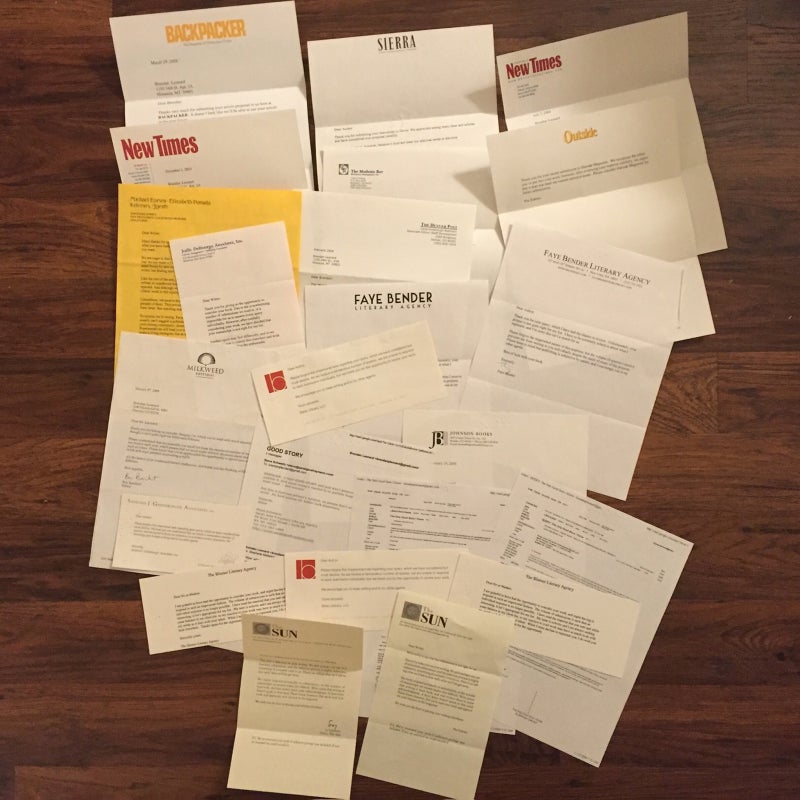
In my second year of pitching stories, I made $75 from one article. I moved to Denver to work at a small newspaper—but on the side, I kept pitching any outdoor publication I thought might pay. Almost all of them sent me rejections. In late 2006, John Fayhee at the Mountain Gazette liked a story I sent him enough to publish it and pay me $100. In mid-2007, I got a part-time job writing funny 100-word blogs for an outdoors website, at 15 cents a word, two to three blogs per week.
I kept working day jobs, first at the newspaper and then at a nonprofit that took urban teens on wilderness trips. After work, I obsessed over rock climbing routes, logistics of road trips I could take during my time off or over three-day weekends, read adventure books and magazines, and checked out guidebooks from the public library. I kept writing and trying to get published, chipping away at that idea of becoming a real writer.
I finally got a small assignment from a big magazine. I would interview a guy named Fitz Cahall, who had a podcast called The Dirtbag Diaries. I did the interview, wrote the 400-word story, sent it in, and… months later, I hadn’t heard from the editor. I checked back a couple times, and somehow the story had gotten lost in the editor’s spam folder. It never ran.
From the interview with Fitz Cahall, I held on to one part of his story: Fitz had wanted to become a magazine writer and had some success at it, but magazines weren’t interested in what he thought were his best story ideas. So he wrote them anyway, recorded them, and made them into a podcast—his own thing.
I ended up writing and recording an episode for The Dirtbag Diaries in mid-2008, starting a years-long relationship with Fitz and Becca Cahall. And, in late 2010, I followed Fitz’s thinking and took my rejected ideas (or ideas that were so ridiculous I’d never even pitched them) and started my own blog. In December 2010, I paid $12.17 for the URL Semi-Rad.com, and started writing short blog posts. I published the first four of them on February 2, 2011, and shared one of the posts with my few hundred Facebook friends and Twitter followers.
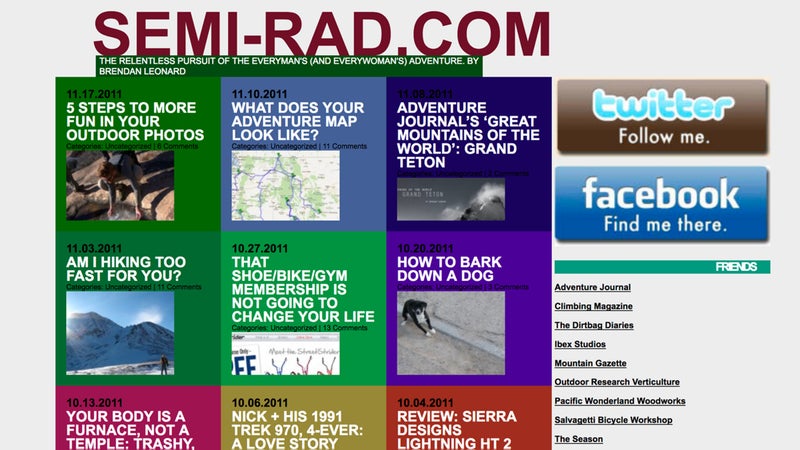
The first month, I published four blog posts, one every Thursday. My friend Josh Barker had told me that a regular publishing schedule would keep readers interested, so I decided to write one blog every week until something happened or I got sick of it. The first month, my blog got 646 page views. Not exactly setting the internet on fire.
The next month, I got 1,810 page views. The next month, still posting every week, 2,085 views, and then 1,506 views the month after that. It went like that for a while. I wrote about pumping your fist out the window of your car at the start of a road trip, about the amount of beer you should pay your friends back with (like letting you borrow gear or digging you out of an avalanche). I wrote about not buying new gear just because you can. Steve Casimiro from �����ԹϺ��� Journal reached out and asked if I would be interested in him re-posting some of my stories on his website and referring traffic back to me? Fuck yes I would. In October, I had more than 12,000 views. That December, Patagonia took out a full-page ad in The New York Times asking consumers if they didn’t need them, so I made a few knock-offs of their design, around other environmental issues. It took off, and that month, I had almost 30,000 page views. More importantly, I had survived 11 months of writing one blog post every week. So I kept going.
After almost six years of trying, I started getting magazine assignments, starting in early 2011 with a story I’d been pitching and had written for Climbing magazine. I started writing more stories for them, and eventually a monthly column—which was titled Semi-Rad, like my blog. Over the course of the next few years, I wrote short and long pieces for almost every magazine I’d wanted to—a gear review here, a short piece in the front of the book there, the occasional feature story. Sometimes I loved the result, sometimes the magazine and I had different goals, and once my name actually got spelled wrong in my byline (not in an outdoor mag, but a men’s magazine doing some outdoor stuff). In mid-2013, I was working on an assignment for an outdoor magazine, and the editor said that when I was writing the feature story we were discussing, I should “imagine if you were writing about it for your blog.”
By the time I’d gotten to write for a few of the outdoor publications I’d always wanted to, I started to realize things were changing, for me and for everyone. In 2004, I’d wanted to write magazine feature stories, Jon Krakauer- and Daniel Duane-style—but in 2014, lots of magazines were shifting resources to online content, and often (but not always) decreasing resources devoted to publishing long features. Gone were the days (that I never experienced) of travel budgets and high-four-figure/five-figure story payouts—the kinds of things that “real writers” had. But the internet, which made life hell for lots of newspapers and magazines, was fantastic for people like me, who could hand-draw a flowchart about or write a half-serious blog post about how much and potentially reach thousands of people—or sometimes, only a few dozen, which happened lots of Thursdays. At the beginning of 2013, I landed a sponsor, Outdoor Research, whose support cosigned my efforts and made sure I had what I needed to keep it going.
In June 2014, I was driving around Garden of the Gods in Colorado Springs doing research for a rock climbing guidebook I was co-authoring. The year before, I had put large “Semi-Rad.com” decals on either side of my Astrovan, which I was living in, thinking I needed to do that in order to deduct mileage on my taxes.
A car started tailgating me around the scenic loop, flashing its headlights. I wondered, “did I just cut that guy off? Is the van on fire?” I pulled over at the next pullout. The car pulled over, a guy got out, and introduced himself. His name was Willie Bailey, and he was a firefighter and photographer from Tennessee. He had been reading my blog for a couple years, and he had just read the road trip book I had self-published and got inspired to take a road trip himself—which he was on. Right now. We chatted a little bit, took a quick photo, and I got back in my van to drive away, thinking that was a pretty heartwarming side effect of writing a blog post every week for three and a half years.
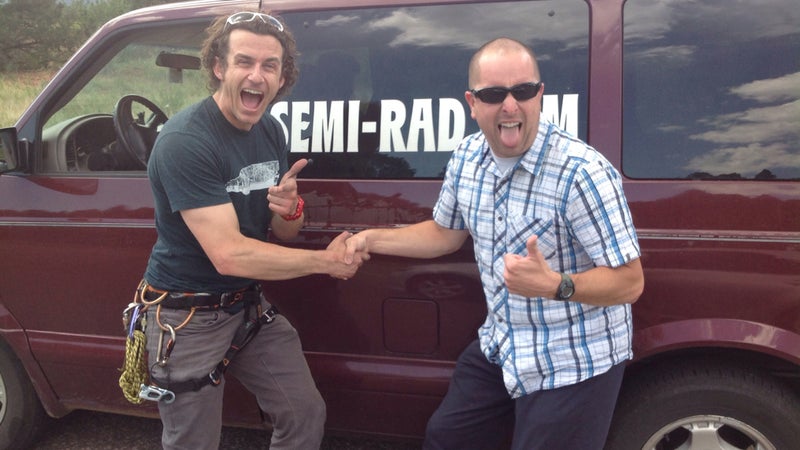
This would happen more times over the next few years, and it’s not something they teach you in journalism school or creative writing classes: if you put a little bit of yourself out there and people can relate to it, sometimes you get to meet people you’d otherwise never meet, and hear a little bit of their story. And you don’t get that in every job.
There’s no monetary reward to having people you don’t know talk about some goofy thing you wrote, and it’s not a Pulitzer or National Magazine Award. But it was something I hadn’t considered when I started writing—that the weird shit I posted on my blog, which falls flat sometimes and makes it a little way around the internet some other times, could also become a piece of dialogue between friends. That not only do they laugh at the joke—which is all you hope for when you’re trying to be funny—but they laugh again later when they say it to a friend.
In late 2014, my friend wrote me an email from a bed and breakfast in Punta Arenas, Chile. He had been sitting on a couch around a wood stove with a group of people who were on their way to Torres del Paine when one of the group “started quoting your ‘’ piece and the rest of the group filled in other memorable lines. I think they've memorized in a way I can only claim for a few Monty Python bits. Even 10,000 miles from home, the world's a smallish place.”
Late last Monday night, I sat in my kitchen hand-writing thank-you postcards to the folks who support my creative efforts on Patreon, and realized my blog at Semi-Rad.com had turned eight years old a few days before. I turned 40 last month, which means I’ve been writing Semi-Rad posts every week for a fifth of my life. If each blog was 500 words long, that’s well over 200,000 words written.
Since I started eight years ago, I’ve been able to successfully explore other ways to make a living besides writing a blog—public speaking, directing short films, writing books, drawing cartoons, and of course, writing for other publications. Some weeks I wondered if I should keep doing the blog, and some weeks it felt like no one read the blog at all.
But I had a place to write where no one told me what I could do and couldn’t do, for better (often) or for worse (hopefully not quite as often). I had a place to write , who wasn’t a famous adventure athlete, but who I still quote to this day. I had a place to write , who climbs at a gym in Iowa, , who doesn’t climb at all, and about my friend Abi when last summer. I wrote a story about my friend Nick’s rabid back in 2010, something he’d forgotten about until I reminded him last week. I don’t know if those stories would ever have gone anywhere if I hadn’t just done them myself, without caring whether 100 people or 100,000 people read them. (And let’s be honest—it was a little closer to 100).
Every once in a while someone asks what the word “Semi-Rad” means, and I explain that when I started the blog, I thought there was already plenty of outdoor media coverage of elite climbers, skiers, runners, and other record-breakers. I wanted to focus on the rest of us who love the outdoors—the things we have in common. I think those things are valuable too, and often ridiculous and worth laughing at.
If you ask any writer how to get started, I think you’ll get countless variations on one piece of common advice: Start writing. You just make yourself do it, even if you’re not sure if it’s any good at first. Writing is a lot like digging a hole in the ground: You only make progress after you actually start.
The one thing I’ve learned from making myself write something every week is this: You can’t hit a home run every week. Maybe you can’t hit a home run every month. But if you keep writing, sometimes you bunt, sometimes you strike out, and sometimes you get a walk. But if you get to first base, there’s someone out there who might need whatever it is you wrote, on that day. Even if the rest of the internet doesn’t seem to notice.
In mid-2017, Jonah Ogles, then an editor at �����ԹϺ���, reached out and asked if I’d be interested in having my Semi-Rad blog posts published as a weekly column on �����ԹϺ��� Online. It was an unexpected, but welcome, honor for a blog born out of the fatigue of trying to get my stuff printed on someone else’s platform.
It was a totally different path than my adventure writing heroes, like Mark Jenkins, took, but making a living as a writer has never been straightforward, maybe less straightforward now than ever. If you had told me in 2008 that it was possible to get a book deal by writing really good Instagram captions, I would have said, “What the hell is Instagram?” in the same way if you’d told Mark Jenkins in 1998 that you could get a book deal by writing a blog, he probably would have said, “What the hell is a blog?” We’re all trying to figure it out as we go, whether you’re a publication like �����ԹϺ��� or a hopeful somebody who just wants a few people to read your stories, in whatever format.
I don’t pretend to speak for all writers, but I think if you’re a writer and you’re honest with yourself, the thing you want most for your writing isn’t money or some sort of fame, but readers. You want a genuine connection with a few people. I don’t know if I’d say everything has turned out like I thought it would, but I’m grateful I found a small community of people who read some of my stories about all the things we love to do outside. I may not be filing dispatches from a base camp in the Karakoram or anything like the legendary writers I read, but I’ve had a great time trying to make sense of all the weird stuff we do out there—getting cold, exhausted, scared, stormed on, wondering why we do it until we get back home and immediately want to do it all again.
Eight years after starting a blog, and picking up that metaphorical shovel every week to keep digging that metaphorical hole, I still can’t say I know what a “real writer” is.
I do have a desk now, though. So I might as well stick with this writing thing.

